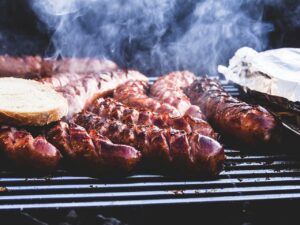Key Takeaway
| Tips for Blackstone Griddle Troubleshooting |
|---|
| 1. Clean the griddle thoroughly before troubleshooting to remove any residue or debris. |
| 2. Check for gas flow and ensure the propane tank is properly connected and turned on. |
| 3. Verify that the igniter is functioning correctly and adjust the electrode distance if necessary. |
| 4. Inspect the burners and clean or replace any clogged or damaged components. |
| 5. Monitor the flame quality and adjust the air shutter for optimal combustion. |
| 6. Keep the griddle level and flat to prevent uneven heating. |
| 7. Refer to the user manual or contact Blackstone customer support for further assistance. |
Troubleshooting Your Blackstone Griddle: Quick Fixes to Common Issues
Are you experiencing problems with your Blackstone griddle? Don’t let the frustration sizzle! Troubleshooting your griddle doesn’t have to be a daunting task. In this article, we will explore some common issues and provide you with practical solutions to keep your griddle cooking up those delicious outdoor meals. So grab your spatula and let’s dive in!
1. Ensure a Clean Cooking Surface
Before diving into troubleshooting, it’s crucial to start with a clean canvas. Blackstone griddles need regular maintenance to keep them in top shape. Remove any leftover food and debris from the griddle surface using a grill brush or scraper. This step is often overlooked but can have a significant impact on performance.
Table 1: Common Causes and Solutions
| Issue | Possible Cause | Solution |
|---|---|---|
| Uneven Heat Distribution | Grease buildup or uneven surface | Clean griddle, level surface, and adjust heat zones if available |
| Weak or No Flame | Lack of gas flow or faulty connection | Check gas supply, connections, and regulator |
| Igniter Not Working | Dirty electrode or faulty igniter | Clean electrode and adjust distance if needed |
| Inconsistent Flame | Misaligned burner or blocked burner holes | Inspect, clean, and adjust burners as necessary |
| Excessive Smoking | Excess grease or improper air-fuel ratio | Clean excess grease and adjust air shutter if applicable |
| Rust or Corrosion | Exposure to moisture or poor maintenance | Address rust areas and practice regular maintenance |
2. Check Gas Flow and Connections
If your griddle is not producing a flame or the flame is weak, it’s essential to verify the gas flow. Check if the propane tank is properly connected and turned on. Ensure the gas valve on the tank is fully open, and there are no kinks or leaks in the hose. A simple obstruction in the gas flow can often be the culprit behind a non-functioning griddle.
3. Troubleshoot Ignition Issues
When the igniter fails to spark or light the burners, troubleshooting the igniter system is necessary. Begin by checking if the electrode is clean and free from grease or debris. Use a clean cloth or paper towel to wipe the electrode gently. If the distance between the electrode and the burner is incorrect, adjust it accordingly.
Table 2: Troubleshooting Ignition
| Issue | Possible Cause | Solution |
|---|---|---|
| No Spark or Ignition | Dirty electrode or faulty wire | Clean electrode or replace the wire |
| Weak or Intermittent Spark | Low battery or faulty module | Replace battery or igniter module |
| Spark but No Flame Ignition | Misaligned electrode or burner | Adjust electrode or clean burner |
4. Inspect and Clean Burners
Clogged or damaged burners can lead to uneven heat distribution, weak flames, or even no flames at all. Regularly inspect the burners for any signs of blockage or corrosion. Clean the burner tubes and holes with a brush or a pipe cleaner to remove any debris that may obstruct the gas flow. If a burner is damaged or rusted beyond repair, it may require replacement.
List 1: Troubleshooting Burner Performance
- Check for clogged burner holes and clean them thoroughly.
- Inspect the burner tubes for damage or corrosion.
- Replace any burners that are beyond repair.
- Ensure proper alignment of the burners for optimal flame coverage.
5. Adjust the Air Shutter for Optimal Combustion
The air shutter on your Blackstone griddle regulates the air-to-gas ratio, ensuring proper combustion. To control the size and quality of the flame, adjust the air shutter accordingly. If you notice excessive smoking, try opening the air shutter slightly to increase air intake. On the contrary, if the flame is too weak or prone to extinguishing, closing the air shutter can help achieve a more concentrated flame.
6. Keep It Level
A level and flat surface are crucial for even heat distribution on your Blackstone griddle. Uneven surfaces can cause hot and cold spots, resulting in uneven cooking. Before troubleshooting any further, make sure your griddle is positioned on a stable and level surface. Adjust the legs or use a leveling tool if necessary.
List 2: Essential Maintenance for Your Blackstone Griddle
- Clean the griddle surface thoroughly after each use.
- Season your griddle regularly to prevent rust and improve non-stick properties.
- Store your griddle in a dry environment to avoid moisture-related issues.
- Perform periodic checks on hoses, connectors, and gas connections.
- Refer to the user manual for specific maintenance instructions from Blackstone.
Conclusion
Don’t let troubleshooting your Blackstone griddle dampen your grilling excitement. With the tips and solutions provided in this article, you’ll be able to tackle common issues with ease.
Remember to keep your griddle clean, check the gas flow and connections, troubleshoot ignition problems, inspect and clean burners, adjust the air shutter, and maintain a level cooking surface.
If you encounter any persistent issues or require further assistance, don’t hesitate to consult the user manual or reach out to Blackstone’s knowledgeable customer support team. Now, get back to savoring those outdoor griddle-cooked creations!
